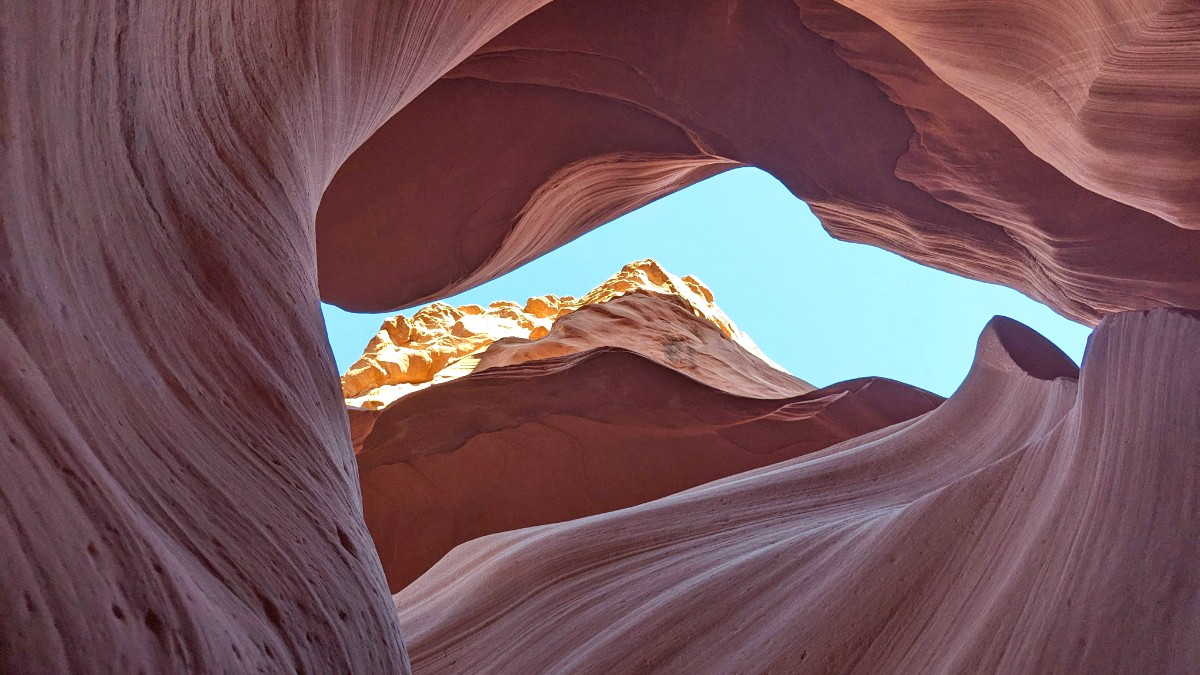
Arizona, USA
Spring (March-May) offers warm and pleasant days, 50°F (10°C) to 80°F (27°C), with cool nights. Fall (September-November) brings similar comfortable daytime temperatures. These periods are comfortable for exploration.
Summer (June-August) is the hottest, reaching 90°F (32°C) and often exceeding 100°F (38°C). Nights offer some relief. Winter (December-February) is the coldest, with days from 30°F (-1°C) to 50°F (10°C) and freezing nights. Precipitation is mostly during monsoon season (July-September), with low humidity year-round.
Flash floods are the most serious weather-related hazard. Intense thunderstorms, even miles upstream from the canyon, send walls of water rushing through the narrow slots. The Navajo Nation Parks & Recreation and all authorized tour operators prioritize visitor safety.
Tours are immediately canceled if there is any flash flood potential, requiring visitors to reschedule or seek refunds. Always comply with guide instructions. Extreme temperatures mean summer heat requires constant hydration and sun protection, while winter cold necessitates warm, layered clothing.
March to October
Prime time for famous light beams in Upper Antelope Canyon. Warm weather for other outdoor activities. Full range of tour options.
Extreme crowds, tours sell out months in advance. Highest prices. High risk of heat exhaustion. Monsoon flash flood risk (July-Sept).
March-April, Late October-November
Moderate crowds. Pleasant temperatures. Better tour availability. Chance for light beams.
Unpredictable weather. Light beams less reliable or dramatic.
December-February
Fewest crowds. Easier tour booking. Soft, diffused light without harsh shadows.
Cold temperatures. No direct light beams in Upper Antelope Canyon. Shorter daylight hours.
For international visitors, a valid passport with any U.S. Visa or approved ESTA authorization. For U.S. Citizens, a valid government-issued photo identification. Your passport must be valid for at least six months beyond your intended stay. Have proof of onward/return travel and be ready to show evidence of sufficient funds.
A Navajo Nation permit fee is for entry to the tribal park. This fee, typically around $8-$10 per person, is almost always included in the price of your guided tour. You pay the combined tour and permit fee when you book your tour with an authorized Navajo operator.
Access to Antelope Canyon is strictly limited to guided tours led by authorized Navajo Nation tour companies. Independent entry is prohibited.
Many operators have discontinued specialized "photography tours" that allowed tripods. Confirm rules regarding professional gear before booking.
Citizens of Visa Waiver Program countries must obtain an approved Electronic System for Travel Authorization (ESTA) prior to travel via IVisa or VisaHQ.
Citizens of non-VWP countries need a B-2 non-immigrant tourist visa. This typically involves an application form (DS-160) and an interview at an U.S. Embassy or consulate.
Upon arrival at an U.S. Airport, you will go through U.S. Customs and Border Protection (CBP). An officer will review your documents and ask about your visit purpose.
Costs vary significantly based on your travel style and the time of year.
The official currency is the United States Dollar (USD, $). Credit cards (Visa, MasterCard, American Express, Discover) are widely accepted. It is recommended to carry some U.S. Cash for smaller purchases and tips. ATMs are available in Page.
Tipping is customary in the U.S.
Prices are subject to change and vary by season and operator.
Prioritizing health and safety is important for any trip, especially when visiting natural environments like Antelope Canyon. Awareness of potential hazards and preparation contribute to a safe and enjoyable experience.
The desert climate is very dry. Drink plenty of water before, during, and after your visit. Carry a reusable water bottle.
A risk during summer when temperatures exceed 100°F (38°C). Stay hydrated, wear light clothing, seek shade.
Canyon floors are sandy, uneven. Lower Antelope Canyon involves ladders. Wear sturdy, closed-toe shoes with good grip.
Page Hospital
Located at 120 S Navajo Dr, Page, AZ. This is the main medical facility in the immediate area, offering emergency services.
For immediate life-threatening emergencies, dial 911 (Police, Fire, Ambulance) in the United States. Pharmacies are available at Bashas' Supermarket and Safeway in Page.
Tap water in Page, AZ, is safe to drink.
Coverage for unexpected illness or injury. Consider World Nomads or SafetyWing.
Reimbursement for non-refundable expenses if your trip is canceled or cut short, including due to flash flood-related tour cancellations.
Coverage for lost luggage, cameras, or other valuables. Products like Pacsafe can offer additional security.
Flash floods are the most significant natural hazard. Slot canyons are susceptible to sudden, powerful flash floods, even if it is not raining directly overhead. Rain upstream can cause a surge of water to rush through the canyon.
Page, AZ, is generally a safe tourist town with low crime rates. The main safety concerns for visitors within Antelope Canyon itself are natural hazards, not crime. Altitude (4,300 feet) can cause mild effects for some.
High desert elevation means intense UV exposure. Apply High-SPF sunscreen generously and reapply often. Wear a Wide-brimmed hat and Sunglasses. Sun Bum Original SPF 50 provides good protection.
The canyon environment can be dusty. Individuals with respiratory sensitivities may consider wearing a bandana or mask to cover their mouth and nose. Protect camera gear from dust.
Always carry a fully charged phone for emergencies. However, do not rely on cellular service within the canyon, as it is often absent.